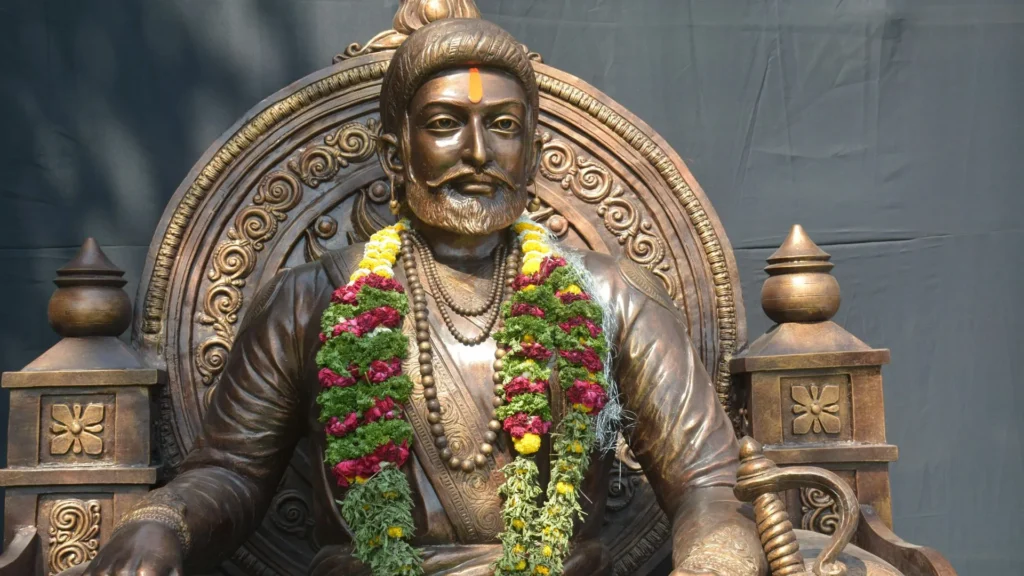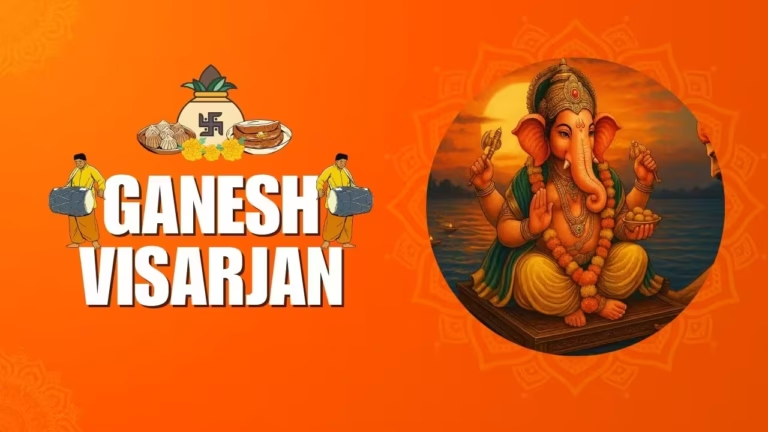Chhatrapati Shivaji Maharaj is one of the greatest and most iconic figures in Indian history. Known as the founder of the Maratha Empire, he was not only a brilliant warrior but also a master strategist, an exceptional administrator, and a champion of Swarajya (self-rule). Shivaji Maharaj’s life story is filled with bravery, inspiration, and a deep commitment to his people and nation.

Table of Contents
Shivaji Jayanti 2025
Shivaji Jayanti, celebrated on February 19 each year, marks the birth anniversary of Chhatrapati Shivaji Maharaj. In 2025, the day will be observed with grand celebrations across Maharashtra and other parts of India. This occasion serves as a tribute to his legacy, inspiring generations with his vision of Swarajya, justice, and valor. Cultural programs, processions, and historical reenactments will be held to honor the great Maratha warrior.
Early Life
Birth and Family Background
Shivaji Maharaj was born on February 19, 1630, at the Shivneri Fort in the Pune district of Maharashtra. His father, Shahaji Raje Bhosale, was a brave and skilled military commander who served under the Adilshahi Sultanate. His mother, Jijabai, was a devout and courageous woman who played a vital role in shaping Shivaji’s character and values.
From an early age, Jijabai instilled in him the principles of justice, courage, and devotion to Hindu dharma. She narrated stories from the Ramayana, Mahabharata, and other religious texts, planting the seeds of nationalism and a sense of duty in young Shivaji. He was also mentored by his teacher, Dadoji Konddev, who trained him in horse riding, swordsmanship, archery, and statecraft.
Education and Training
Shivaji Maharaj received rigorous training in various aspects of warfare, including guerrilla tactics, fortifications, and naval defense. His early years were marked by a strong focus on military training, governance, and strategic planning. His interactions with seasoned warriors and administrators shaped his vision of Swarajya.
Foundation of the Maratha Empire
The Oath of Swarajya
At the young age of 15, Shivaji took an oath to establish Swarajya, a self-governing state free from the rule of foreign powers. He started by capturing several forts and consolidating his power in the western part of India.
Early Military Campaigns
- Conquest of Torna Fort (1645): This was Shivaji Maharaj’s first major victory, which he achieved at the age of 16. This laid the foundation for further conquests.
- Capture of Rajgad, Purandar, and Sinhagad Forts: These victories strengthened the Maratha military presence and gave Shivaji a stronghold in the region.
- Raid on Surat (1664): Shivaji strategically attacked the Mughal port city of Surat, taking advantage of the Mughal Empire’s weaknesses and collecting substantial wealth to fund his military campaigns.
Conflict with the Mughals
Battle with Shaista Khan (1660-1663)
Mughal general Shaista Khan captured Pune and established his control over the region. In 1663, Shivaji launched a surprise midnight raid on Shaista Khan’s residence, injuring him and killing several Mughal soldiers. This attack weakened the Mughal presence in the Deccan.
Treaty of Purandar (1665)
The Mughal Emperor Aurangzeb sent Raja Jai Singh to suppress Shivaji Maharaj. Following a series of battles, Shivaji was forced to sign the Treaty of Purandar, surrendering 23 forts to the Mughals.
Escape from Agra (1666)
In 1666, Shivaji was invited to the Mughal court in Agra, where he was deceitfully imprisoned by Aurangzeb. Using his intelligence and strategic planning, Shivaji disguised himself and escaped from captivity by hiding in a basket of sweets.
Rise of the Maratha Empire
Coronation as Chhatrapati (1674)
On June 6, 1674, Shivaji Maharaj was coronated as Chhatrapati at Raigad Fort. This event marked the formal establishment of the Maratha Empire. Shivaji’s administration was known for its efficiency, justice, and fairness to all, regardless of caste or religion.
Administrative Reforms
- Ashtapradhan Mandal: Shivaji established a council of eight ministers to ensure effective governance. The council included the Peshwa (Prime Minister), Senapati (Commander-in-Chief), and other key officials.
- Military Reforms: He built a strong navy to protect the coastline and established a network of forts to defend his territory.
- Justice System: Shivaji implemented a fair and impartial justice system, protecting the rights of farmers, traders, and common citizens.
Military Strategies
Shivaji Maharaj was a master of military tactics. His most famous strategy, known as “Ganimi Kava” or guerrilla warfare, involved sudden attacks on enemy forces followed by rapid retreats to safety. This approach allowed him to defeat much larger and better-equipped armies.
- Fortification Strategy: Shivaji constructed and secured over 300 forts, including strategic locations like Raigad, Pratapgad, and Sindhudurg.
- Naval Power: Shivaji was the first Indian ruler to establish a formidable navy, ensuring the safety of the western coastline from foreign invasions.
- Use of Intelligence: He developed a strong spy network to gather information about enemy movements and tactics.
Shivaji Maharaj’s Swords: A Detailed Account
Chhatrapati Shivaji Maharaj’s swords symbolize his valor, prowess, and exceptional combat skills. These swords were not just weapons but representations of his indomitable spirit and martial excellence. Shivaji Maharaj possessed three renowned swords, each holding historical and cultural significance.
- Bhavani Sword
- Jagdamba Sword
- Tulja Sword
1. Bhavani Sword
Introduction
- The Bhavani Sword is one of the most famous swords of Chhatrapati Shivaji Maharaj.
- This sword was known for its unique combination of artistry and deadly efficiency.
- Legend states that it was gifted to Shivaji Maharaj by Goddess Tulja Bhavani, which is why it is named “Bhavani Sword.”
Features
- It was a lightweight yet razor-sharp sword, making it ideal for swift attacks.
- A blend of Indian and Persian sword craftsmanship was evident in its design.
- The sword measured around 40-45 inches in length and weighed between 1.5 to 2 kg.
- Its slightly curved blade enhanced its cutting efficiency in battle.
Historical Importance
- Many believe that the sword was divinely blessed and played a crucial role in Shivaji Maharaj’s military victories.
- It was instrumental in his guerrilla warfare strategy, making it a significant asset in battle.
- Shivaji Maharaj used this sword to defeat many adversaries, cementing its legendary status.
Current Status
- The Bhavani Sword was once kept at the British Museum in London.
- Efforts have been made to bring it back to India, but its authenticity has been a matter of debate.
2. Jagdamba Sword
Introduction
- The Jagdamba Sword is another historically significant weapon associated with Shivaji Maharaj.
- It was officially recognized as a heritage artifact by the British government.
- Later, it was returned to India and is now housed in the Chhatrapati Shivaji Museum in Kolhapur.
Features
- Slightly smaller than the Bhavani Sword, yet exceptionally sharp and durable.
- It measured around 39 inches in length and weighed approximately 2 kg.
- The blade was beautifully adorned with gold and silver engravings, making it an exquisite artifact.
Historical Importance
- The sword was used as a symbol of honor and victory.
- It was often presented to commanders and nobles as a mark of distinction.
- The Jagdamba Sword remains an emblem of Maratha heritage and pride.
Current Status
- The sword is currently preserved in Satara, Maharashtra, where it is displayed for public viewing.
3. Tulja Sword
Introduction
- The Tulja Sword is believed to have a deep connection with the Tulja Bhavani Temple.
- It is said that Shivaji Maharaj kept this sword for special occasions and personal protection.
Features
- Heavier than the Bhavani and Jagdamba swords, making it ideal for powerful strikes.
- Its length was approximately 42 inches, and it weighed around 2.5 kg.
- The blade had a slight curvature, making it efficient for both slashing and stabbing.
Historical Importance
- It was considered a sacred weapon, symbolizing divine protection.
- Shivaji Maharaj reportedly used this sword in many crucial battles.
- The Tulja Sword is deeply associated with religious significance and is revered in Maharashtra.
Current Status
- This sword is still preserved in a museum in Maharashtra, where it remains a part of India’s cultural heritage.
Shivaji Maharaj’s mastery over these swords and his exceptional sword-fighting skills contributed significantly to his military dominance. These weapons were not just instruments of war but embodied his legacy of valor and courage.
Important Battles and Victories
- Battle of Pratapgad (1659): Shivaji defeated the powerful general Afzal Khan of the Adilshahi Sultanate using his clever tactics.
- Battle of Sinhagad (1670): The brave warrior Tanaji Malusare captured the fort but lost his life in the process. Shivaji, moved by his sacrifice, remarked, “The fort has been won, but I have lost my lion.”
Death and Legacy
Chhatrapati Shivaji Maharaj passed away on April 3, 1680, at Raigad Fort. His death remains a subject of speculation, with some sources attributing it to illness while others suggest conspiracy theories. After his death, his son Sambhaji Maharaj took over the leadership of the Maratha Empire and continued to fight against the Mughals and other adversaries.
Contributions and Legacy
- Foundation of Swarajya: Shivaji Maharaj’s concept of Swarajya laid the groundwork for Indian independence movements.
- Defender of Dharma: He protected Hindu culture and traditions during a time of widespread oppression.
- Military Genius: His guerrilla tactics and fortification strategies are still studied in military academies.
- Icon of Leadership: Shivaji Maharaj’s leadership, vision, and dedication to justice continue to inspire millions.
Chhatrapati Shivaji Maharaj was not just a warrior, but a true nation-builder whose legacy lives on as an inspiration for generations. His life and accomplishments remain a symbol of courage, leadership, and unwavering commitment to the ideals of justice and freedom.
Conclusion
Chhatrapati Shivaji Maharaj’s life was a saga of valor, leadership, and devotion to his people. He stands as one of the greatest leaders in Indian history, whose vision and courage laid the foundation for the Maratha Empire and inspired countless others to fight for justice and freedom.
“Jai Bhavani! Jai Shivaji!”
Read This article in hindi : छत्रपति शिवाजी महाराज: एक महान योद्धा | Chhatrapati shivaji maharaj



